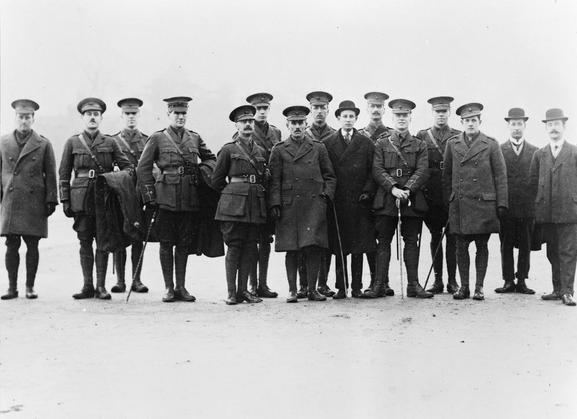 | ||
The 9th (County of London) Battalion, London Regiment (Queen Victoria's Rifles) was a Territorial Army infantry battalion of the British Army. The London Regiment was formed in 1908 in order to regiment the various Volunteer Force battalions in the newly formed County of London, and the Queen Victoria's Rifles were one of twenty six units brought together in this way.
Contents
Early history
The Queen Victoria’s Rifles could trace their origins back to the old volunteer regiments of the Napoleonic Wars when the Duke of Cumberland’s Sharpshooters were formed as a Corps of Riflemen on September 5, 1803.
Many transformations occurred over the next century until the passing of the Territorial and Reserve Forces Act came into effect on April 1, 1908 and the old volunteer regiments were reorganised into the new Territorial Force. In this way the QVRs were formed by the amalgamation of:
World War I
The QVRs arrived in Le Havre on November 5 1914, one of the first Territorial battalions to serve in France; they were attached to the 13th Brigade of the 5th Division.
On 17 April 1915, an attack was mounted on Hill 60 by the 13th Brigade which included:
The Hill was a small promontory on the edge of the Ypres Salient that afforded good views for the Germans across the British lines and in to Ypres. It was therefore of great tactical significance to both sides who "fought with great gallantry".
Prior to the attack, the hill had been undermined for days with five galleries being driven under the German positions. The plan was to detonate large mines under the hill to destroy the enemy and their positions, then the 13th Brigade would occupy the area. The Hill was captured on April 17 and on April 20, two and a half companies of the QVRs were ordered up to the front line as the enemy made a counter-attack.
At dawn on 21 April, the Germans began bombarding the QVRs with hand grenades. Casualties were heavy, including two officers, Major Lees and Lieutenant Summerhays who were killed. It was then that Lieutenant Geoffrey Harold Woolley left a position of safety to take command of the soldiers on the Hill. Only 40 QVRs were left in the front line, but by rallying the troops with encouragement and letting the men know that reinforcements were on the way, Woolley helped repulse the counter-attack by throwing bombs (grenades) at the advancing Germans. For his gallantry Lieutenant Woolley was awarded the Victoria Cross, the first to be won by the Territorial Force.
The QVRs remained in France for the rest of the war. Their losses are remembered at Hill 60 by the QVR memorial and at the nearby QVR café and museum.
Post-World War I
Between the wars, the 9th London Regiment (Queen Victoria's Rifles) was affiliated to the King's Royal Rifle Corps and re-constituted as two motorized infantry battalions and became the Territorial Army units of the KRRC.
World War II
At the outbreak of World War II (1939–45), 1/QVR was serving as part of the 1st London Division and was designated a motor-cycle reconnaissance battalion, armed with revolvers instead of rifles. In May 1940, the battalion was transferred to the 30th Infantry Brigade, and was hurriedly sent across the English Channel, but, due to an error, their motor cycles and sidecars were left in England. They fought in the desperate siege of Calais between 23 and 26 May, which bought valuable time for the British Expeditionary Force (BEF) to be evacuated from Dunkirk. Suffering very heavy losses, most of the battalion were either killed or captured and the battalion had to be reconstituted from scratch.
After returning to the United Kingdom, , in December, the battalion became part of the war-raised 27th Armoured Brigade, then serving under command of the 9th Armoured Division, and was designated as the 7th Battalion, King's Royal Rifle Corps on 1 April 1941. The battalion saw no further active service during the war and remained in the United Kingdom until April 1943, when it was disbanded.
The 2nd Battalion was, like the 1st Battalion, originally serving in a motorised reconnaissance role as part of the 2nd London Division, and, in December 1940, transferred to help create the 28th Armoured Brigade and was redesignated as the 8th Battalion, King's Royal Rifle Corps the following month. The battalion remained with the brigade until July 1944, when the brigade was broken up. It became part of the 35th Tank Brigade in September, serving mainly in a draft-finding role. The battalion was disbanded in 1946.
Postwar
After the war, the Queen Victoria's Rifles was merged with the Queen's Westminsters to form the Queen's Royal Rifles on May 1 1961.
